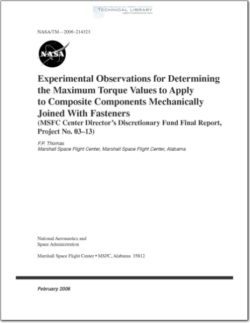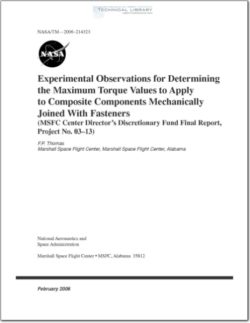NASA-TM-2006-214323

- Version
- 528 Downloads
- 2.11 MB File Size
- 1 File Count
- April 6, 2016 Create Date
- April 6, 2016 Last Updated
Experimental Observation for Determining the Maximum Torque Values to Apply to Composite Components Mechanically Joined with Fasteners

Aerospace structures utilize innovative, lightweight composite materials for exploration activities
in low—Earth orbit for the Space Shuttle and the International Space Station. Composite structures will
be used for future space exploration beyond low—Earth orbit to the moon, Mars, and other destinations
in crew exploration vehicles and habitats. These structural components will take advantage of the high
strength—to—weight ratio, good thermal characteristics, and tailorability offered by composite structures.
For a variety of reasons, including size limitations, manufacturing facilities, contractual obligations,
or particular design requirements, the joining of composite components will be required. Adhesively
bonded and mechanically fastened joints are common methodologies for joining composite components
that have analytical precedence and practical applications. In some applications both methods are simul—
taneously incorporated into the design. Guidelines and recommendations for establishing design criteria,
analyzing, and testing composites are readily available for engineers to adapt for their particular appli—
cations. However, guidelines and recommendations, based on analysis and testing, are not available
for specifying a fastener torque range used in joining composite components. The intent of this investi—
gation is to develop an initial process for determining the maximum torque values to apply to mechani—
cal fasteners used to join composite components and hence, the initiation of a recommended torque
limit that designers utilize when specifying torque values to join composite components with mechan—
ical fasteners.
The objective of this investigation is to develop an initial process for determining the maximum
torque values to apply to mechanical fasteners used to join composite components, and select an
acceptable nondestructive failure detection methodology to determine composite specimen failure.
The intent is to generate a recommended torque limit to apply to composite components joined with
mechanical fasteners that designers specify on manufacturing drawings.
| File | Action |
|---|---|
| NASA-TM-2006-214323 Experimental Observation for Determining the Maximum Torque Values to Apply to Composite Components Mechanically Joined with Fasteners.pdf | Download |
Comment On This Post